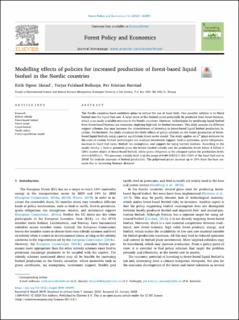| dc.contributor.author | Jåstad, Eirik Ogner | |
| dc.contributor.author | Bolkesjø, Torjus Folsland | |
| dc.contributor.author | Rørstad, Per Kristian | |
| dc.date.accessioned | 2022-03-11T12:44:26Z | |
| dc.date.available | 2022-03-11T12:44:26Z | |
| dc.date.created | 2020-10-23T07:04:35Z | |
| dc.date.issued | 2020 | |
| dc.identifier.citation | Forest Policy and Economics. 2020, 113 . | |
| dc.identifier.issn | 1389-9341 | |
| dc.identifier.uri | https://hdl.handle.net/11250/2984661 | |
| dc.description.abstract | The Nordic countries have ambitious plans to reduce the use of fossil fuels. One possible solution is to blend biofuel into the liquid fuel mix. A large share of this biofuel could potentially be produced from forest biomass, which is an easily available resource in the Nordic countries. However, technologies for producing liquid biofuel from forest-based biomass are immature, implying high risk for biofuel investors. This study assesses six different support schemes that may increase the attractiveness of investing in forest-based liquid biofuel production facilities. Furthermore, the study simulates the likely effects of policy schemes on the future production of forestbased liquid biofuels using a partial equilibrium forest sector model. The study applies an nth plant estimate for the costs of various biofuel technologies and analyses investment support, feed-in premiums, quota obligations, increase in fossil fuel taxes, biofuel tax exemptions, and support for using harvest residues. According to the model results, a feed-in premium gives the lowest needed subsidy cost for production levels below 6 billion L (25% market share) of forest-based biofuel, while quota obligation is the cheapest option for production levels above 6 billion L. The necessary subsidy level is in the range of 0.60–0.85 €/L (82–116% of the fossil fuel cost in 2030) for realistic amounts of biofuel production. The pulpwood prices increase up to 24% from the base scenario due to increasing biomass demand. | |
| dc.language.iso | eng | |
| dc.title | Modelling effects of policies for increased production of forest-based liquid biofuel in the Nordic countries | |
| dc.type | Peer reviewed | |
| dc.type | Journal article | |
| dc.description.version | publishedVersion | |
| dc.source.pagenumber | 16 | |
| dc.source.volume | 113 | |
| dc.source.journal | Forest Policy and Economics | |
| dc.identifier.doi | 10.1016/j.forpol.2020.102091 | |
| dc.identifier.cristin | 1841683 | |
| dc.relation.project | Norges forskningsråd: 255265 | |
| dc.relation.project | Norges forskningsråd: 257622 | |
| cristin.ispublished | true | |
| cristin.fulltext | original | |
| cristin.qualitycode | 1 | |
